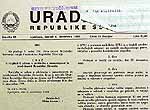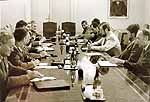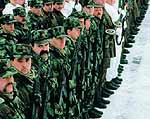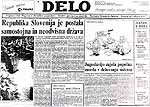
Chronology of major events
6 December 1990 - The Plebiscite Law for the Independence
and Sovereignty of the Republic of Slovenia is adopted by the Assembly
of the Republic of Slovenia.
23 December 1990 - A Plebiscite on the Independence of the
Republic of Slovenia is held.
26 December 1990 - Plebiscite results are officially
announced. Turnout for the plebiscite was 93.2% of those eligible to
vote. 88.5% said "yes" to an independent and sovereign
Slovenia. Prior to the plebiscite a Declaration to Respect the
Fundamental Conventions of the European Council is adopted by the
Assembly.
8 January 1991 - Serbian authorities "invade" the
Yugoslav finance system and "borrow" 18 billion, 243 million
dinars from the first Yugoslav National Bank issue (1.4 billion
dollars or almost half of the common loans based on the first 1991
issue for all Yugoslav banks). This is the beginning of the end of the
Yugoslav economy.
9 January 1991 - The Slovenian government publishes a
memorandum in which it criticises the federal government because of
its slow, inappropriate reaction to the disintegration of the Yugoslav
economic system.
9 January 1991 - Based on a proposal made by the Yugoslav
People's Army (YPA) leadership the Federal Presidency issues a decree
for the return of any illegally obtained weapons and the disarmament
of all special units that are not part of the YPA. Stipe Mesic and
Janez Drnovsek oppose this decree.
10 January 1991 - Representatives of the Yugoslav Republics
meet in Belgrade to discuss the future of the federation.
 |  |
The Plebiscite Law
Photo: Military History Centre Archives |
 |  |
The voting paper for the Plebiscite
Photo: Military History Centre Archives |
 |  |
Talks with the Yugoslav People's Army generals, July 1990
Photo: Military History Centre Archives |
11 January 1991 - The Assembly adopts the Slovenian
government memorandum and tasks the government with drafting a
proposal by 23 January for activities to implement the objectives
stated in the plebiscite, in particular the proposal for the peaceful
dissolution of Yugoslavia and the proposal for measures to be taken by
Slovenia for admission into the UN.
20 February 1991 - The Slovenian parliament adopts a
resolution in which it suggested to parliaments in other republics
that the Socialist Federal Republic of Yugoslavia (SFRY) be dissolved
in a friendly way. The dissolution was top result in the establishment
of two or more independent, sovereign countries. With the adoption of
amendments to the Slovenian constitution all of the articles that
transfer sovereignty from the Republic to the Federation are annulled.
1 March 1991 - The Federal Presidency rejects the Slovenian
and Croatian proposal for the peaceful dissolution of the SFRY.
8 March 1991 - A constitutional law, in which Slovenian
conscripts are no longer obliged to do their military service in the
Yugoslav People's Army is passed by the Slovenian Parliament.
12 March 1991 - The YPA leadership call a session of the
Federal Presidency. During this session they propose that a state of
emergency throughout the country be declared.
13 March 1991 - Without informing the SFRY government, the
Federal Secretary for National Defence, General Veljko Kadijevic, and
some of his colleagues, travel to Moscow for secret talks and ask for
support. They are refused.
18 March 1991 - The Slovenian presidency forms a contingency
planning coordination body for a state of emergency. This body is
tasked with the coordination of all important measures in order to
protect the level of independence achieved by Slovenia. In wartime it
is to coordinate military, political and diplomatic efforts.
19 March 1991 - The War Council, an informal body of the
highest ranking YPA military representatives, announces a resolution
that prohibits any border changes and armed conflict between peoples.
It demands that the YPA be financed regularly, territorial defence
forces be put under the authority of the YPA again, and that
uninterrupted recruiting be assured. This proposal is welcomed by the
President of the Federal Government Ante Markovic, who demands that
Slovenia transfer the command of the Territorial Defence forces to the
YPA and revoke the resolution that blocks the sending of Slovenian
recruits to the YPA. Soon after, the YPA threatens to come to Slovenia
and fetch the recruits if Slovenia does not begin sending them again
by 15 May.
1 April 1991 - During a session of all three chambers, the
first entirely independent budget is adopted by the Slovenian
Assembly.
6 April 1991 - A new Defence and Protection Law that had
been adopted by the Assembly on
29 March is published in the RS Official Gazette, No
15-555/91.
18 April 1991 - Representatives of the Yugoslav Republics
meet in Brdo pri Kranju and present two possible forms for the future
organisation of the country. In the first option, SFRY would become a
federation of sovereign countries, or a confederation. In the second
option, it would remain a uniform federal country, or a federation. A
decision is to be announced in the next few months, but in never was.
24 April 1991 - The Federal Department of Finance drafts a
decree on the implementation of regulations for the payment of customs
duties and tasks the police forces and the army with the
implementation of this decree.
27 April 1991 - The following legislation is published in
the RS Official Gazette, No 18- 791/91: Military Duty Law, Decree for
the Formation of Territorial Defence Commands and Institutions in the
Republic of Slovenia, and the Decree for the Determination of Criteria
for the Formation of the Regular Structure of Territorial Defence
District Commands.
April 1991 - A course for the leadership, officers and
instructors of the first two training centres is organised in Poljce.
 |  |
Line-up of the Territorial Defence Forces in Kocevska Reka, 17 December 1990
Photo: Military History Centre Archives |
 |  |
"Republic of Slovenia became an independent state",
Delo, December 27, 1990
Photo: Military History Centre Archives |
4 May 1991 - The following laws pertaining independence are
adopted by the Slovenian assembly: The Citizenship Law, The Slovenian
National Bank Law and The Foreign Credit Business Law.
8 May 1991 - A constitutional law on National Defence that
specifies the use of all available military capabilities for the
defence of Slovenia is adopted by the National Assembly.
15 May 1991 - The first class of Slovenian soldiers begins
their training in the first two TD training centres in Pekre pri
Mariboru and at Ig pri Ljubljani. Stipe Mesic is not elected the new
President of the SFRY Presidency.
23 May 1991 - An incident occurs between TD and YPA
representatives in the Pekre training centre.
24 May 1991 - During negotiations the Commander of the TD
Territorial Command, Vladimir Milosevic, and TD officer Milko Ozmec
are kidnapped by the YPA. Josef Simcik is killed after being run down
by an armoured personnel carrier leaving the Vojvoda Misic barracks.
May 1991 - 180 conscripts begin their obligatory military
service at the Ig and 120 at the Pekre training centre.
2 June 1991 - The first soldier swears his allegiance to
Slovenia.
5 June 1991 - The last package of legislation for
independence is adopted by the Slovenian assembly.
A Slovenian delegation, consisting of Milan Kucan, Janez Drnovsek
and Lojze Peterle, travel to Belgrade to negotiate concerning
Slovenian independence with the Federal Prime Minister Ante Markovic
and the Federal Secretary of Defence Veljko Kadijevic. The suggestions
made by the federal side are unacceptable.
12 June 1991 - Ante Markovic visits Slovenia at the
invitation of the Slovenian leadership and assures Assembly
representatives that the federal government does not wish to use
force.
21 June 1991 - During a session of the Federal Chamber of
the Yugoslav Assembly Ante Markovic points out that the federal
government intend to use all of the available legal mechanisms to
prevent unilateral changes to both internal or external borders. 10 RS
Territorial Defence aircraft are removed from the Cerklje airfield by
the YPA.
23 June 1991 - EEC members agree not to recognise the
independence of Slovenia and Croatia if they unilaterally secede from
the Yugoslav federation.
24 June 1991 - A new Slovenian coat of arms and a new
Slovenian flag are designed.
25 June 1991 - The Slovenian Parliament adopts a
constitutional law that implements the Basic Charter of the
Independence and Sovereignty of the Republic of Slovenia, the
Declaration of Independence and several additional laws that enable
Slovenia to take over the authority previously held by the federal
government on Slovenian territory.
26 June 1991 - Slovenia is declared an independent country
by President Milan Kucan at a ceremony held in Trg Revolucije square,
Ljubljana.
|